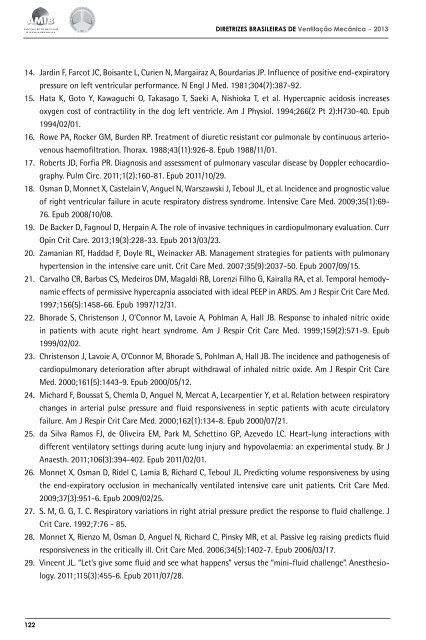2V4vSHf0l
2V4vSHf0l
2V4vSHf0l
Create successful ePaper yourself
Turn your PDF publications into a flip-book with our unique Google optimized e-Paper software.
DIRETRIZES BRASILEIRAS DE Ventilação Mecânica – 2013<br />
14. Jardin F, Farcot JC, Boisante L, Curien N, Margairaz A, Bourdarias JP. Influence of positive end-expiratory<br />
pressure on left ventricular performance. N Engl J Med. 1981;304(7):387-92.<br />
15. Hata K, Goto Y, Kawaguchi O, Takasago T, Saeki A, Nishioka T, et al. Hypercapnic acidosis increases<br />
oxygen cost of contractility in the dog left ventricle. Am J Physiol. 1994;266(2 Pt 2):H730-40. Epub<br />
1994/02/01.<br />
16. Rowe PA, Rocker GM, Burden RP. Treatment of diuretic resistant cor pulmonale by continuous arteriovenous<br />
haemofiltration. Thorax. 1988;43(11):926-8. Epub 1988/11/01.<br />
17. Roberts JD, Forfia PR. Diagnosis and assessment of pulmonary vascular disease by Doppler echocardiography.<br />
Pulm Circ. 2011;1(2):160-81. Epub 2011/10/29.<br />
18. Osman D, Monnet X, Castelain V, Anguel N, Warszawski J, Teboul JL, et al. Incidence and prognostic value<br />
of right ventricular failure in acute respiratory distress syndrome. Intensive Care Med. 2009;35(1):69-<br />
76. Epub 2008/10/08.<br />
19. De Backer D, Fagnoul D, Herpain A. The role of invasive techniques in cardiopulmonary evaluation. Curr<br />
Opin Crit Care. 2013;19(3):228-33. Epub 2013/03/23.<br />
20. Zamanian RT, Haddad F, Doyle RL, Weinacker AB. Management strategies for patients with pulmonary<br />
hypertension in the intensive care unit. Crit Care Med. 2007;35(9):2037-50. Epub 2007/09/15.<br />
21. Carvalho CR, Barbas CS, Medeiros DM, Magaldi RB, Lorenzi Filho G, Kairalla RA, et al. Temporal hemodynamic<br />
effects of permissive hypercapnia associated with ideal PEEP in ARDS. Am J Respir Crit Care Med.<br />
1997;156(5):1458-66. Epub 1997/12/31.<br />
22. Bhorade S, Christenson J, O’Connor M, Lavoie A, Pohlman A, Hall JB. Response to inhaled nitric oxide<br />
in patients with acute right heart syndrome. Am J Respir Crit Care Med. 1999;159(2):571-9. Epub<br />
1999/02/02.<br />
23. Christenson J, Lavoie A, O’Connor M, Bhorade S, Pohlman A, Hall JB. The incidence and pathogenesis of<br />
cardiopulmonary deterioration after abrupt withdrawal of inhaled nitric oxide. Am J Respir Crit Care<br />
Med. 2000;161(5):1443-9. Epub 2000/05/12.<br />
24. Michard F, Boussat S, Chemla D, Anguel N, Mercat A, Lecarpentier Y, et al. Relation between respiratory<br />
changes in arterial pulse pressure and fluid responsiveness in septic patients with acute circulatory<br />
failure. Am J Respir Crit Care Med. 2000;162(1):134-8. Epub 2000/07/21.<br />
25. da Silva Ramos FJ, de Oliveira EM, Park M, Schettino GP, Azevedo LC. Heart-lung interactions with<br />
different ventilatory settings during acute lung injury and hypovolaemia: an experimental study. Br J<br />
Anaesth. 2011;106(3):394-402. Epub 2011/02/01.<br />
26. Monnet X, Osman D, Ridel C, Lamia B, Richard C, Teboul JL. Predicting volume responsiveness by using<br />
the end-expiratory occlusion in mechanically ventilated intensive care unit patients. Crit Care Med.<br />
2009;37(3):951-6. Epub 2009/02/25.<br />
27. S. M, G. G, T. C. Respiratory variations in right atrial pressure predict the response to fluid challenge. J<br />
Crit Care. 1992;7:76 - 85.<br />
28. Monnet X, Rienzo M, Osman D, Anguel N, Richard C, Pinsky MR, et al. Passive leg raising predicts fluid<br />
responsiveness in the critically ill. Crit Care Med. 2006;34(5):1402-7. Epub 2006/03/17.<br />
29. Vincent JL. “Let’s give some fluid and see what happens” versus the “mini-fluid challenge”. Anesthesiology.<br />
2011;115(3):455-6. Epub 2011/07/28.<br />
122


